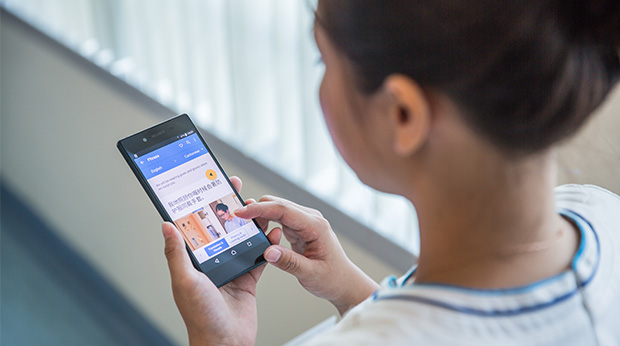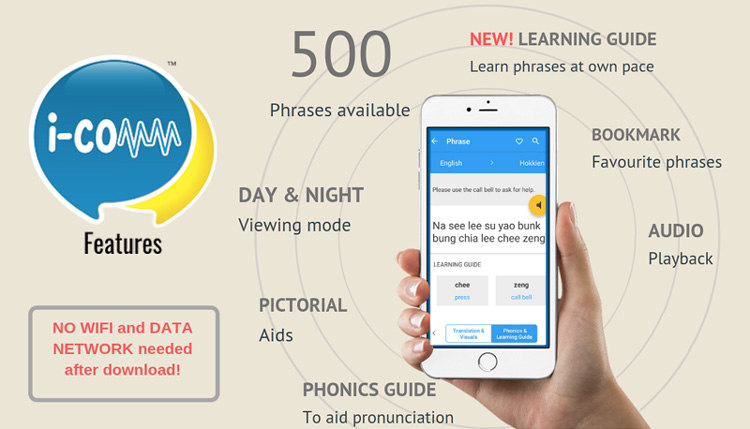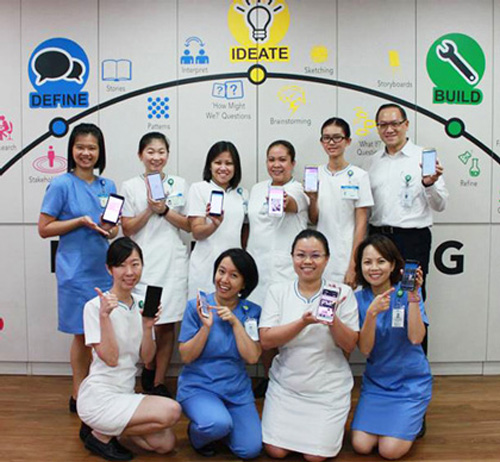It was a scene that was all too familiar to the nursing staff at Changi General Hospital (CGH). During an observational study, a team of nurses from Nursing Quality noticed an Indian nurse struggling with a Hokkien-speaking elderly patient for a simple orientation questionnaire.
“Most of the questions required only a simple yes or no response,” said Nurse Manager (NM) Nuri Ng, who was part of the team. Yet every day, nurses have to engage in charades with the elderly just to communicate simple instructions.
A survey conducted subsequently showed that one in two nurses who are under the age of 35, are not conversant in dialects. And two in five nurses will seek translation help from a colleague daily.
Clearly, something had to change.
Let’s speak the same language
The team brainstormed and tried to find “handy and easy” applications to aid in translation. But they couldn’t find any that was healthcare focused, or provided translations that were similar to how Singaporeans speak.
With the support and collaboration with the hospital’s Office of Innovation and Integrated Health Information Systems (IHiS), what resulted was the prototype of the i-COMM mobile application in 2014, the first local dialect translation app in Singapore for use in hospitals.

The prototype contained 100 commonly used nursing phrases translated from English to Cantonese. One simply clicks on a phrase and the app would provide the audio playback in dialect. And if that wasn’t clear enough, accompanying visual aids helped reinforce the message.
The project was a laborious undertaking, from requirements gathering, translation of phrases, recording of phrases to photo taking. “The team did all the voice recordings in a tight storeroom as it was the quietest place!” said Senior Staff Nurse Lee Sze Wen, who was another member of the team. Two other members also took pictures of commonly used hospital items included in the app.
But the hard work paid off. In a post-pilot survey among nurses who tried the prototype, 97 per cent wanted to continue using i-COMM, but also requested for more languages and phrases.
i-COMM enhanced
Fast-forward to 2018, the team has given i-COMM a mighty boost. The enhanced app, which costs US$0.99 per download, comes with these useful features:

> Multiple languages
The app contains 500 commonly used phrases in Malay, Hokkien and Cantonese. Perfecting the library and voice over recordings were resource-heavy tasks. Even with professional translators and voice talents, the team had to review each and every phrase to ensure it was accurate and colloquial. For example, a simple question such as, “Please use the call bell to ask for help”, when translated, has varied accents and sounds too formal. These were fine-tuned and adjusted before the final product.
> Favourites
Users can bookmark their frequently used phrases and easily locate them each time they open the app.
> Visual aids
Photographs were professionally taken at the hospital so patients can better relate to the setting.
> Phonics and Learning guide
The app serves as a language tutor too. With added phonics, users can learn to pronounce the lines. “Maybe one day, staff may even be proficient enough to do without the app,” says Deputy Director of Nursing (DDN) Wong Kok Cheong. “With i-COMM, nurses can self-learn and may not need to rely on taking additional language classes,” he added.
> Expandable modules
i-COMM now comes with two categories – common greetings and nursing phrases. The team has received requests from allied health colleagues to include rehabilitation phrases in future.
i-COMM has even captured the interest of healthcare workers from the United States. DDN Wong recalls during his visit to some hospitals there, “I demonstrated i-COMM to some nurses, and they commented ‘why don’t we have [something like] this too?’ They were inspired by the idea as they also have to work with non-English-speaking patients.”
DDN Wong also notes the app’s potential to go beyond hospital walls such as in step-down care organisations.
Improving patient experience
More than just a nifty app, i-COMM translates directly to better patient care and safety. “Communication is a common root cause for medical errors. If we can equip nurses and other co-workers with a language tool that they can carry around, we can then provide the right care with the right communication,” said DDN Wong.

As usage of i-COMM grows, the team hopes the app would be further enhanced with more languages, phrases and modules to cater to different needs of healthcare workers. “Perhaps one day, the app may even facilitate a two-way conversation between patients and care providers,” said NM Ng.

